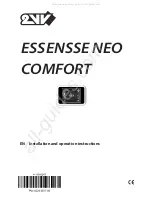
10 of 35
Opus Control Wiring and Programming Installation Manual
www.NabcoEntrances.com
P/N C-00139
Rev 3-9-18
8.2.2 Cancel Passcode or Reset to Default
Passcode
Stroke Learning
Yes No
Short
Push
Reset to Default Set
LEVEL 2
Reset to Default Set
If you don’t know
the passcode,
Keep Pushing Switch,
Return to Normal mode
0
Short
Push
Reset to Default Set
If you don’t know
the passcode,
Keep Pushing Switch,
Return to Normal mode
0 0
Short
Push
Reset to Default Set
If you don’t know
the passcode,
Keep Pushing Switch,
Return to Normal mode
0 0 0
Rotate
Dial
Reset to Default Set
If you don’t know
the passcode,
Keep Pushing Switch,
Return to Normal mode
0 0 4
Short
Push
Reset to Default Set
If you don’t know
the passcode,
Keep Pushing Switch,
Return to Normal mode
0 0 4 4
Rotate
Dial
0 0 4 5
Short
Push
Correct PassCode!
If you don’t know
the password,
Keep Pushing Switch,
Return to Normal mode
0 0 4 5
Reset to Default Set
If you don’t know
the passcode,
Keep Pushing Switch,
Return to Normal mode
DN 1712
Figure 8 Cancel Passcode
8.2.3 Stroke Learning
Stroke Learning is used to measure from Fully Closed to Fully Open points in effort to determine where Check Points should happen.
Stroke Learning is also used to determine if an existing Operator Type is correct, and/or to determine if Handing is correct.
1. Briefly press down on the Rotary Dial to select:
X
Yes
• Opus will start the Stroke Learning Cycle
• The Control will check to see if the Door is fully closed → Open Slowly → Close Again
X
No
• If the Operator and Door Handing settings are correct, Opus will not have to Learn Stroke. Opus automatically
determines the Stroke during a normal door cycle.
• If the Door Hand are the wrong setting, the following messages after the Stroke Learning Cycle will display:
“Wrong Hand! Restroke”. If this event occurs, enter the proper settings within the Base Setting Category
screens.
SECTION 8.3: Level Three and Four: Setting Category and Menu Items
Short
Push
DN 1716
Passcode
Stroke Learning
Yes No
Go to Se ng menu
Se ng Category
Base Se ng
Movement Se ng
Op onal Se ng
Output Se ng
Input Se ng
History Data
LEVEL 3
Low Energy or Full
Low
Full
Rotate
Dial
LEVEL 4
LEVEL 2
Long Push
Long Push
Figure 9 Example: Program Control for Low or Full Energy











































